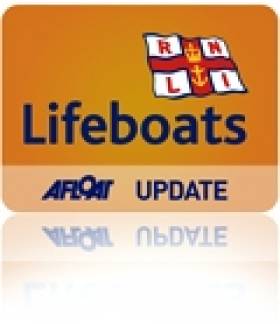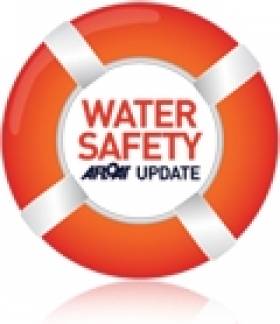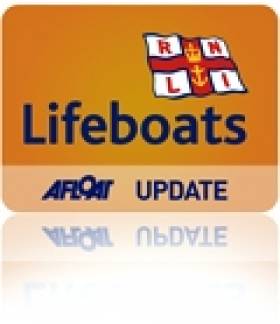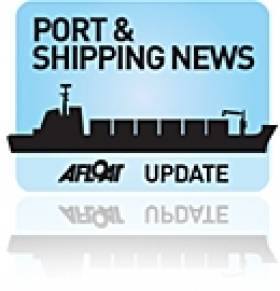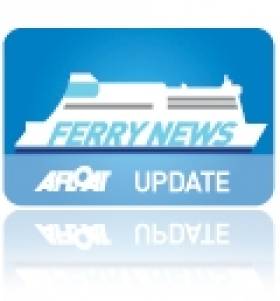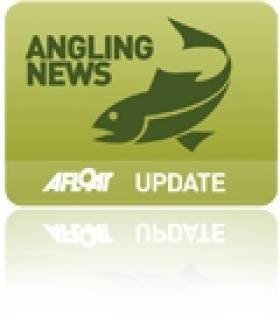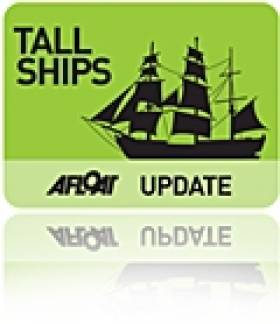Displaying items by tag: Rosslare
#RNLI - The volunteer lifeboat crew of the Courtown lifeboat launched last Wednesday evening (24 July) to a report of a small fishing boat that was overdue on its time to return to Cahore Pier.
The Courtown RNLI lifeboat, Cahore Inshore Rescue, the Rosslare RNLI lifeboat and the Irish Coast Guard helicopter Rescue 117 were all tasked at 7pm to search the area of Cahore on the north Wexford coast, where the boat was last reported fishing.
After searching for some time, the small fishing boat made contact to say they had beached their boat some eight miles north of Cahore Pier at Kilgorman Beach. Both men were safe and well and all rescue services were stood down.
The Courtown lifeboat has since urged all boat users carry a proper means of communication - ideally a VHF radio - and to keep friends and family up to date on their location, especially if they decide to change their location.
That same evening, Rosslare Harbour RNLI was involved in a search for two fishermen after they reported getting into difficulty off the Wexford coast.
The volunteer crew launched their all-weather lifeboat at 7.30pm to assist in the search following a request from the coastguard to attend a fishing boat that was reported to be taking on water.
Weather conditions at the time were described as good, with a southerly force three wind.
The fishing boat had set out from Cahore Harbour before getting into trouble. The two crew raised the alarm using a mobile telephone.
Rosslare Harbour RNLI and lifeboats from Courtown RNLI and Cahore, along with the Rescue 117 helicopter, joined in the search.
At 7.50pm, Rescue 117 located the two fishermen safe and well and their vessel on the beach at Glasgorman, near Cahore.
Speaking after the call-out, Rosslare Harbour RNLI deputy volunteer lifeboat press officer Jamie Ryan said: "The emergency services responded swiftly and were on scene quickly.
"The two fishermen did the right thing by raising the alarm when they got into difficulty and thankfully they were both found safely ashore."
Rosslare RNLI Praises Emergency Caller Despite False Alarm
#WaterSafety - Rosslare RNLI has given credit to the quick-thinking member of the public who raised the alarm over what they believed to be a swimmer in difficulty - even though the call-out turned out to be a false alarm.
Lifeboats from Rosslare Harbour and Wexford RNLI were involved in the sea search on Friday evening (19 July) after a swimmer was reported to be in difficulty off Curracloe beach in Co Wexford.
The Irish Coast Guard helicopter Rescue 117 and two local fishing vessels were also involved in the search, which was stood down after an hour and 45 minutes upon coastguard request as no one was reported missing.
Speaking after the call-out, Rosslare RNLI deputy launching authority Dave Maloney said: "The member of the public who raised the alarm this evening deserves credit for doing so."
He added: "We would always encourage the public to alert the emergency services if they see anyone they believe to be in trouble or any signs of danger."
The message is particularly important in a fortnight that has seen a shocking 10 drownings around the island of Ireland - resulting in a big rise in emergency call-outs over the 2012 mid-summer period.
Elsewhere on the same day, the Ballycotton RNLI lifeboat was requested to help search the water off Ballinamona Strand in Ballycotton Bay, Co Cork, for a missing five-year-old girl.
The little girl was playing on the strand when her family lost sight of her. Emergency services were alerted and a search of the area commenced, but thankfully a short while later the little girl was located safe and well.
In other water safety news, the Irish Coast Guard has issued a public appeal for help locating a training mannequin that was lost in Galway Bay during an exercise off Blackhead in North Clare last week.
The Connacht Tribune reports that five coastguard mannequins were placed in the water to acts as people who jumped overboard from a ship fire - but only four were recovered afterwards.
Lifeboat Rescues Lone Yachtsman off Grounded Vessel
#rnli – Rosslare RNLI launched in the early hours of this morning (11 June) when a lone yachtsman issued a Mayday call after his vessel grounded. Unable to give his exact position the lifeboat crew searched the area before they located him on his 27 foot yacht which was grounded between Curracloe and Blackwater in Wexford.
The lifeboat launched at 1.10am under the command of Second Coxswain Keith Miller and proceeded to Maurice Castle, where it was thought the yacht was located. However on arriving at the scene it was discovered the yacht was not there and the lifeboat crew widened their search.
Rosslare RNLI Launching Authority Dave Maloney successfully made contact with the sailor from the watch tower in Rosslare Harbour and asked the man to stay on his VHF radio counting to ten so that the lifeboat crew would pick it up and be able to pinpoint his position. They located him between Curracloe and Blackwater shortly after 3am and discovered that the vessel was hard aground and would not move.
They were close to shore and two volunteer lifeboat crew launched the inflatable Y boat from the lifeboat to recover the man from the vessel but the incoming surf flipped the boat and made it impossible to recover the man. The two lifeboat crew then waded into the water to the yacht and safely recovered the man, who was wearing his lifejacket, from the vessel. They then accompanied him back to shore where they were met by members of Curracloe Coast Guard.
Commenting on the callout, Rosslare RNLI Deputy Launching Authority Dave Maloney said, "This was a very early morning callout for the lifeboat crew and was carried out in complete darkness. When the lone sailor was unable to give his position the priority was to locate him and make sure he was safe. Thankfully when we established contact with him we were able to locate him and safely accompany him back to shore."
#RosslarePort - RTÉ News reports that two men are due before a special sitting of Wexford District Court this morning (Sunday 5 May) on drug smuggling charges after being stopped on entry at Rosslare Europort.
The Lithuanian men were stopped in their van as is drove off a ferry from France at Rosslare on Friday after customs drug dog Ralph indicated the presence of drugs in the vehicle, according to The Irish Times.
Upon search, customs officers discovered a haul of heroin and amphetamines with a street value of some €190,000 - along with a cache of steroids, tobacco and alcohol.
As The Daily Edge reports, Ralph the sniffer dog has been with Revenue's Customs Service since last summer working the Rosslare entry port, where he has previously sniffed out more than €300,000 worth of cannabis resin.
Rosslare RNLI Launches To Drifting Vessel In Severe Winds
#RNLI - The volunteer lifeboat crew with Rosslare Harbour RNLI launched at 10.30am on Wednesday morning (6 February) to a fishing vessel drifting dangerously close to the shore in a force 8 gale (see video below).
The vessel was located about a mile from the lifeboat station in Rosslare Harbour and the lifeboat was on scene within minutes.
Two volunteer lifeboat crew were transferred to the drifting vessel whose moorings were unable to hold due to an unexpected change in the wind direction, and brought it under control in severe weather conditions.
The vessel was brought safely to the main harbour and secured. The callout last just over two hours.
Commenting on the callout, Rosslare Harbour RNLI deputy launching authority David Maloney said: "Weather conditions this morning in Rosslare Bay were very challenging and the crew showed great skill in bringing the vessel to safety.
"If the lifeboat had not launched, I have no doubt that the vessel would have been washed ashore."
Ferries in Collision at Rosslare Harbour
#FERRY NEWS - A Stena Line ferry was unable to dock in Rosslare last night after a collision with an Irish Ferries passenger craft in heavy winds.
TheJournal.ie reports that the Stena Europe ferry was attempting to dock at Rosslare Harbour after its arrival from Fishguard around 6pm when it made contact with the starboard bow of the Oscar Wilde, which was stationary in port.
RTÉ News says that neither vessel was badly damaged in the incident, but docking was postponed pending the departure of the Irish Ferries vessel, which was expected around 11.30pm last night.
More than 500 passengers and crew were on board the ferry at the time of the incident, which occurred amid gusts of up to 35 knots.
The return journey to Fishguard and this morning's Fishguard-Rosslare sailing were cancelled while an inspection of the vessel gets underway.
Generosity of Agencies, Businesses Saves Rosslare Small Boats Festival
#ANGLING - For the third time in four years an Irish boat has won the Rosslare Small Boats Festival, which took place from 8-15 September.
In what was an extremely tight competition, Screaming Reels from Rosies Sea Angling Club in Cork won the competition with 24 different species of fish, beating 28 other boats from the UK.
Sponsored by Inland Fisheries Ireland (IFI), Fáilte Ireland and Sea Angler magazine, the event - now in its 27th year - attracted more than 85 anglers from the Isle of Wight, Southport, Liverpool, Wales and Ireland.
This year’s event faced some challenges, most notably that prior to the competition going ahead the accommodation company Self Catering Ireland went bust in July, meaning the anglers had nowhere to stay.
IFI and Fáilte Ireland came to the rescue by sponsoring the prizes to the tune of €3,000, with the original prize fund going to refinance accommodation for participants.
This generosity was replicated by local businesses who realised the importance and the value of this competition to Wexford, and many prizes were received. These included donations from Sea Angler magazine, Sefton Sea Anglers, Wirral Boat Angling Club in Liverpool, Kelly’s Resort Hotel and Spa, Redmond’s The Bay, Grangewood Holiday Homes, Grangecove Holiday Homes, Southside Angling, Kilmore Quay Harbour office and Widgeon’s Rest.
The weather conditions proved to be very challenging for the competition, with southwesterly winds making boat angling very difficult.
However as the week wore on, conditions improved slightly and competitors managed to fish the normally four-day competition in three days by launching their boats once from Kilrane in Rosslare and twice from Kilmore Quay, and fishing restricted areas along the Wexford coast.
A great variety of fish were recorded during the week with 30 different types of species including coalfish, dogfish, dab, flounder, pollack, bull huss and some unusual species such as sea scorpion, shanny and tadpole fish.
There were also some fantastic specimen fish reeled in during the week including a triggerfish of 2.32kg caught by well known UK angler and writer Gordon Thornes from the boat Uptide Girl, which is very close to the Irish record of 2.54 kg.
Two other specimens recorded include a fine ballan wrasse of 3.16kg caught by Neville Murphy from Cork and a smoothound of 3.78kg caught by Seirt Shults of Dundalk, both from the winning boat Screaming Reels. (All specimen fish are pending verification by the Irish Specimen Fish Committee.)
The competition was exciting from start to finish due to the close results each day, despite the changeable weather conditions. And the overall results demonstrated this, with first place going to Screaming Reels (Martyn Rayner, Seirt Shults, Neville Murphy) with 24 species for 23.12kg - followed closely in second place by Uptide Girl (Gordon Thornes, Mike Roberts and John Williams from Wallasey in the UK) with 22 species for 25.15kg. In third place was Nirvana (Richie Stead and Keith Pemberton from the Wirral Boat Angling Club in Liverpool) with 20 species for 13.78kg.
The heaviest round fish was a conger of 8.18kg caught by Leslie Trish of Seeker V from Liverpool, who was also awarded a perpetual trophy sponsored by Inland Fisheries Ireland for the biggest fish caught. The heaviest flat fish was a plaice of 0.80kg caught by John Meaning from Joe 90 from the Isle of Wight. Fifteen-year-old Lewis Radcliffe from Wigan won best junior of the competition, fishing with his dad Simon and his grandfather on the boat Cod n Bas’ which came fifth with 19 species for a 13.04kg total.
Redmond's The Bay on Rosslare Strand hosted the prizegiving ceremony for the second year running. Prizes were presented by Suzanne Campion, director of business development at Inland Fisheries Ireland and Orla Woods, projects officer for destination development with Fáilte Ireland.
Campion commented that the festival "is very important not only to promote the great sea fishing we have on the east coast, and in particular the variety of species available, but also the investment it brings to the local businesses in the area each year."
She also thanked Phil Hallsworth, who has organised this festival for the last 12 years, for his "hard work, commitment and dedication" now that he is retiring from the event.
Next year’s Rosslare Small Boats Festival will take place on 14-21 September 2013, and IFI invites all small boat anglers to take part. Further information is available from Josie Mahon at 01 278 7022 or [email protected].
Yacht Towed to Harbour after Collision with Tall Ship
The lifeboat launched at 2.38am and was on scene at 3.32am. Reports had been received from Dublin Coast Guard that the yacht was in urgent need of assistance after being damaged on collision with another vessel and was taking on water.
Arriving on scene the volunteer lifeboat crew saw debris in the water and noticed a considerable amount of damage to the yacht on the port side. They immediately assessed the state of the crew on both vessels, fifteen were onboard the Tall Ship and a single crewmember onboard the yacht.
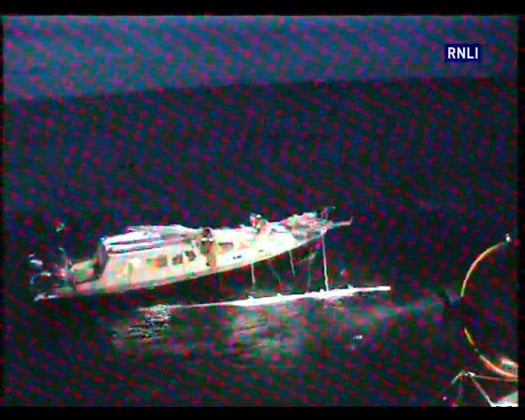
The casualty vessel - Photo: RNLI
On establishing there were no injuries three lifeboat crew boarded the yacht and cleared some of the debris from the water. Due to the damage the lifeboat crew took the yacht under tow back to Rosslare Harbour and the Tall ship made its way on to Waterford.
The Irish Coast Guard Helicopter from Waterford arrived on scene and provided a strong search light overhead for the crews to work in. Conditions were good with a slight swell.
Commenting on the callout, Rosslare Deputy Launching Authority Dave Maloney said, " While there was damage to one of the vessels thankfully there was no serious injury to any person. The priority for the lifeboat crews was to ensure that there was no danger to anyone and that the vessel was taken back to shore as quickly as possible due to the threat of sinking.”
Reviving the Age of Steam for Waterford's Tall Ships
In The Irish Times on Thursday, Tim Sweetman from Islandbridge writes that steam trains could add a touch of old-fashioned glamour to the Tall Ships Races in Waterford this summer.
"Perhaps Irish Rail and the Railway Preservation Society might come together to provide more atmosphere," he suggests. "There's a perfectly good line available from Waterford to Rosslare that is looking for some business."
What else could be done to make the most of the Tall Ships visit? Make your own suggestions in the comments below!
Ferry-Go-Round on the Irish Sea
In the case of Irish Ferries, their Rosslare-Pembroke Dock route vessel, Isle of Inishmore arrived on the Mersey yesterday at the Cammell Laird dry-dock facility in Birkenhead.
The 1997 Dutch-built Isle of Inishmore had relieved the 50,938 tonnes 'flagship' Ulysses from the Dublin-Holyhead route which too had gone to Birkenhead for maintenance since January 4th.
The Ulysses is now back on service and the company's French routes cruiseferry, Oscar Wilde is covering the Isle of Inishmore's absence from Rosslare-Pembroke Dock sailings.
Continental services to France on the Rosslare-Cherbourg route will resume on February 16th when the Oscar Wilde returns from her overall. The Bahamas flagged vessel will re-open seasonal Rosslare-Roscoff sailings starting on May 13th.
In addition to conventional tonnage Irish Ferries also operate the fast-craft catamaran Jonathan Swift in tandem with Ulysses on the Dublin-Holyhead route. The Ulysses takes 3 hours 25 minutes while the 39-knot catamaran craft marketed as the Dublin 'Swift' is advertised with a scheduled passage time of 1 hour and 49 minutes.
The Australian-built catamaran was taken off the central corridor route yesterday to be drydocked also in Birkenhead until January 18th. Dublin Swift sailings return to the Dublin-Holyhead route on February 19th with the first crossing to depart at 14.30 hours from the capital port.
For the latest information on ferry sailings and reservations click: www.irishferries.com



























